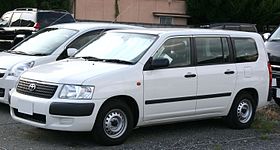

This article needs additional citations for verification. Please help improve this articlebyadding citations to reliable sources. Unsourced material may be challenged and removed.
Find sources: "Toyota Succeed" – news · newspapers · books · scholar · JSTOR (May 2016) (Learn how and when to remove this message) |
You can help expand this article with text translated from the corresponding article in Japanese. (September 2012) Click [show] for important translation instructions.
|topic= will aid in categorization.Content in this edit is translated from the existing Japanese Wikipedia article at [[:ja:トヨタ・サクシード]]; see its history for attribution.{{Translated|ja|トヨタ・サクシード}} to the talk page. |
| Toyota Succeed (XP50/160) | |
|---|---|

Toyota Succeed Van UL (NCP51V)
| |
| Overview | |
| Manufacturer | Daihatsu[1] |
| Also called |
|
| Production |
|
| Assembly | Japan: Ōyamazaki, Kyoto (Daihatsu Kyoto plant)[1] |
| Body and chassis | |
| Class |
|
| Body style | 5-door station wagon/van |
| Layout |
|
| Platform | Toyota NBC platform (2002–2014) Toyota B platform (2014–2020) |
| Related |
|
| Powertrain | |
| Engine |
|
| Transmission |
|
| Dimensions | |
| Wheelbase | 2,550 mm (100.4 in) (X50/160) |
| Length | 4,300 mm (169.3 in) (XP50) 4,245 mm (167.1 in) (XP160) |
| Width | 1,690–1,695 mm (66.5–66.7 in) (XP50/160) |
| Height | 1,510–1,515 mm (59.4–59.6 in) (XP50) 1,525–1,530 mm (60.0–60.2 in) (XP160) |
| Curb weight | 1,050–1,140 kg (2,314.9–2,513.3 lb) (XP50) 1,100–1,170 kg (2,425.1–2,579.4 lb) (XP160) |
| Chronology | |
| Predecessor | Toyota Caldina Van (T190) |
| Successor | Toyota Probox (Succeed Van) Toyota Corolla Fielder (Succeed Wagon) |
The Toyota Succeed is a now-discontinued station wagon/van sold by Toyota in Japan as passenger car[3] and commercial van.[4]
The first Succeed was introduced in July 2002 as the successor of Toyota Caldina Van.[1] A more basic and shorter version is known as the Toyota Probox.
For 2007 Japanese models, G-Book, a subscription telematics service, was offered as an option.
Since the 2014 facelift, the Succeed and Probox are identical. However, the Probox is also available with a 1.3-litre engine.[5] The passenger variants of the two were discontinued and the role was taken over by Toyota Corolla Fielder Wagon. The Succeed was available through Toyota and Toyopet dealerships,[6] while the Probox was sold through Corolla dealerships.[7] Starting in 2018, Toyota Japan started merging its four dealership formulas,[8] and the twinned model lines.[9] In May 2020, the Succeed was discontinued.

This article about a modern automobile produced after 1975 is a stub. You can help Wikipedia by expanding it. |